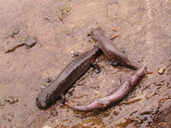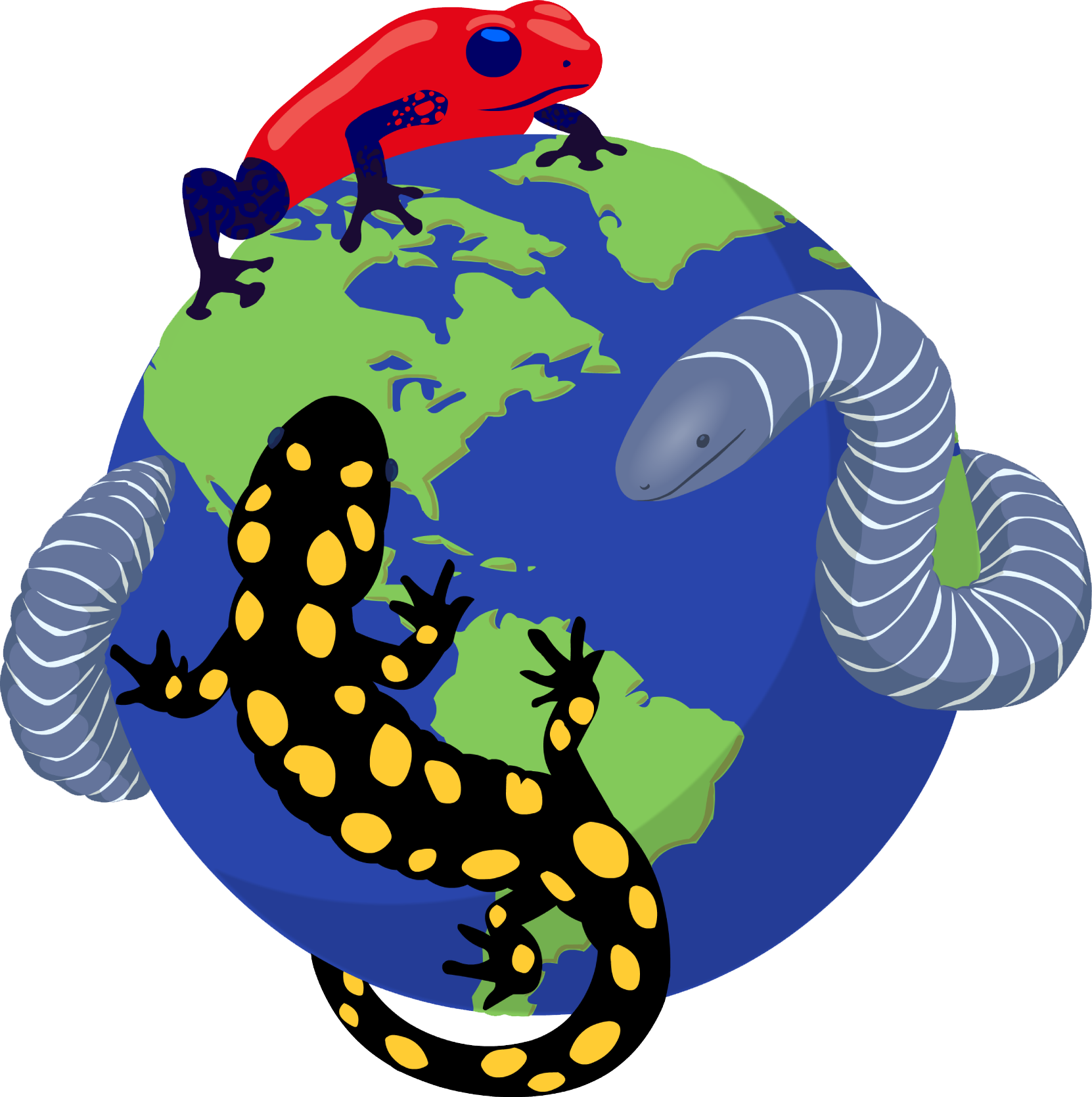|
Pseudoeurycea obesa Parra-Olea, García-París, Hanken & Wake, 2005
Ridge Tail Salamander, Salamandra de Cola Estriada | family: Plethodontidae subfamily: Hemidactyliinae genus: Pseudoeurycea |
| Species Description: Parra-Olea G, Garcia-Paris M, Hanken J, Wake DB 2005 Two new species of Pseudoeurycea (Caudata: Plethodontidae) from the moutains of northern Oaxaca, Mexico. Copeia 2005:461-469 | |
|
Etymology: The species epithet refers to the general more robust body shape of the species in comparison to other Pseudoeurycea species (Parra-Olea et al. 2005). |
|
 © 2014 David Wake (1 of 4) |
|
|
|
Description Pseudoeurycea obesa is characterized by its robust body, the presence of two glandular ridges that are yellow-brown in color, situated dorsolaterally around the pelvis and the base of the tail. It is further identified by a distinct light-yellow coloration on the distal one-third of the tail, which contrasts with its darker grey-brown dorsum and tail base. The flanks of the body are slightly paler and mottled, while the posterior side of the limb base shows reddish marks. The species differs from closely related species P. werleri and P. mystax by its more robust body shape and the distinct yellow-brown glandular ridges around the pelvic region and tail base. It is further distinguished from congeneric species by the shape and coloration of its tail: stout and strongly tapered, and pale-yellow at the terminal third (also see sections above and below) (Parra-Olea et al. 2005). In life, the coloration is brown-gray on the head to slate gray on the dorsum. The dorsum is marbled with brown and rusty areas. The rusty areas that are situated mid-dorsally are bigger around the nape and pelvis. The dorsal side of the body and the tail show black spots of variable sizes that are larger and more oval-shaped on the tail. Smaller blue-silver dots are densely represented on the limbs and the lateral sides, and more sparsely found on the dorsum and head. The glandular ridges are yellow-brown, and the base of the limbs show rusty-orange patches on the posterior side. The tail is dark brown anteriorly, morphing into its distinctive light-yellow coloration at the distal end. The iris has a reddish-brown base color with a reticulated pattern of dark brown (Parra-Olea et al. 2005). Juveniles are noted to be similar in coloration but exhibit fewer black dorsal spots (Parra-Olea et al. 2005). Distribution and Habitat Country distribution from AmphibiaWeb's database: Mexico
Life History, Abundance, Activity, and Special Behaviors Larva Trends and Threats The species was given an Environmental Vulnerability Score of 18 (out of 19) based on its highly confined distribution and the degree of specialization of its putative reproductive mode, suggesting a very high vulnerability to environmental degradation (Wilson et al. 2013; Johnson et al. 2017). In the absence of demographic data, model predictions incorporating life-history traits and environmental threat levels suggest that P. obesa is most likely decreasing (Quintero et al. 2014). Relation to Humans Possible reasons for amphibian decline General habitat alteration and loss Comments References IUCN SSC Amphibian Specialist Group. (2016) Pseudoeurycea obesa. The IUCN Red List of Threatened Species 2016: e.T61909A53989532. https://dx.doi.org/10.2305/IUCN.UK.2016-3.RLTS.T61909A53989532.en. Accessed on 23 November 2023. Johnson, J. D., Wilson L.D., Mata-Silva V., García-Padilla E., and DeSantis, D.L. (2017). The endemic herpetofauna of Mexico: organisms of global significance in severe peril. Mesoamerican Herpetology, 4, 544–620. [link] Mata-Silva, V., García-Padilla, E., Rocha, A., DeSantis, D.L., Johnson, J.D., Ramírez-Bautista, A., and Wilson, L.D. (2021). A reexamination of the herpetofauna of Oaxaca, Mexico: composition update, physiographic distribution, and conservation commentary. Zootaxa, 4996, 201–252. [link] Parra-Olea, G., García París, M., Hanken, J., and Wake, D.B. (2005). Two new species of Pseudoeurycea (Caudata: Plethodontidae) from the mountains of northern Oaxaca. Copeia, 2005(3), 461–469. [link] Quintero, E., Thessen, A.E., Arias-Caballero, P., and Ayala-Orozco, B. (2014) A statistical assessment of population trends for data deficient Mexican amphibians. PeerJ, 2, e703. [link] Rovito, S.M., Parra-Olea, G., Recuero, E., and Wake, D.B. (2015). Diversification and biogeographic history of Neotropical plethodontid salamanders. Zoological Journal of the Linnean Society, 175(1), 167–188. [link] Wilson, L.D., Johnson, J.D., and Mata-Silva, V. (2013). A conservation reassessment of the amphibians of Mexico based on the EVS measure. Amphibian and Reptile Conservation, 7(1), 97–127(e69). [link] Originally submitted by: Jesse Erens (2023-11-27) Description by: Jesse Erens (updated 2023-11-27)
Distribution by: Jesse Erens (updated 2023-11-27)
Life history by: Jesse Erens (updated 2023-11-27)
Larva by: Jesse Erens (updated 2023-11-27)
Trends and threats by: Jesse Erens (updated 2023-11-27)
Relation to humans by: Jesse Erens (updated 2023-11-27)
Comments by: Jesse Erens (updated 2023-11-27)
Edited by: Ann T. Chang (2024-08-22) Species Account Citation: AmphibiaWeb 2024 Pseudoeurycea obesa: Ridge Tail Salamander <https://amphibiaweb.org/species/6530> University of California, Berkeley, CA, USA. Accessed Feb 7, 2025.
Feedback or comments about this page.
Citation: AmphibiaWeb. 2025. <https://amphibiaweb.org> University of California, Berkeley, CA, USA. Accessed 7 Feb 2025. AmphibiaWeb's policy on data use. |


 Raffaëlli Account
Raffaëlli Account Map of Life
Map of Life